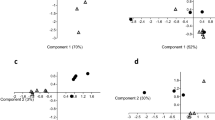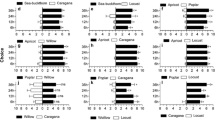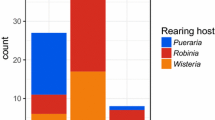Abstract
The feeding behavior of final-instar nymphs ofSchistocerca americana was observed when they first encountered plants that ranged in acceptability from being eaten in large amounts to not being eaten at all. Growth and survival on the same plants through the last stadium were also studied and the results combined as a suitability index to facilitate comparison with the behavior. Although the plants that were eaten most gave the highest suitability index and those that were not eaten permitted no survival, there was no simple relationship between the amounts eaten and the suitability for growth and survival. The possibility that the insects might become habituated to plants that were initially unacceptable was investigated, but no habituation was found over a 3-day period. It is suggested that food intake is largely determined by the presence of deterrent compounds in the less acceptable foods and that nutritional differences between the plants are likely to have been of minor importance. The behavior on some foods suggests that food aversion learning may be involved. It is concluded that the variability of the insects' behavior makes it impossible to predict the suitability of a plant from their immediate behavioral responses. In the field, insects may sometimes reject foods that would be suitable for survival and development, and feed on plants that are nutritionally deficient or even toxic.
Similar content being viewed by others
References
Bernays, E. A. (1990). Plant secondary compounds deterrent but not toxic to the grass specialist acrididLocusta migratoria: Implications for the evolution of graminivory.Entomol. Exp. Appl. 54: 53–56.
Bernays, E. A. (1991). Relationship between deterrence and toxicity of plant secondary compounds for the grasshopperSchistocerca gregaria.J. Chem. Ecol. 17: 2519–2526.
Bernays, E. A., and Chapman, R. F. (1973a). The regulation of feeding inLocusta migratoria: Internal inhibitory mechanisms.Entomol. Exp. Appl. 16: 329–342.
Bernays, E. A., and Chapman, R. F. (1973b). The role of food plants in the survival and development ofChortoicetes terminifera (Walker) under drought conditions.Aust. J. Zool. 21: 575–592.
Bernays, E. A., and Chapman, R. F. (1974). The regulation of food intake by acridids.In Barton Browne, L. (ed.),Experimental Analysis of Insect Behavior, Springer-Verlag, Berlin, pp. 48–59.
Bernays, E. A., and Chapman, R. F. (1978). Plant chemistry and Acridoid feeding behavior. In Harborne, J. B. (ed.),Biochemical Aspects of Plant and Animal Coevolution, Academic Press, London, pp. 99–141.
Bernays, E. A., and Lee, J. C. (1988). Food aversion learning in the polyphagous grasshopperSchistocerca americana.Physiol. Entomol. 13: 131–137.
Capinera, J. L. (1993). Host-plant selection bySchistocerca americana (Orthoptera, Acrididae).Environ. Entomol. 22: 127–133.
Champagne, D. E., and Bernays, E. A. (1991). Phytosterol unsuitability as a factor mediating food aversion learning in the grasshopperSchistocerca americana.Physiol. Entomol. 16: 391–400.
Chapman, R. F. (1982). Regulation of food intake by phytophagous insects. In Addink, A. D. F., and Spronk, N. (eds.),Exogenous and Endogenous Influences on Metabolic and Neural Control, Vol. 1, Pergamon Press, Oxford, pp. 19–30.
Chapman, R. F. (1988). Variations in the size of the midgut caeca during the fifth instar of the grasshopperSchistocerca americana (Drury).J. Insect Physiol. 34: 329–335.
Chapman, R. F., and Beerling, E. A. M. (1990). The pattern of feeding of first instar nymphs ofSchistocerca americana.Physiol. Entomol. 15: 1–12.
Chapman, R. F., Ascoli-Christensen, A., and White, P. R. (1991). Sensory coding for feeding deterrence in the grasshopperSchistocerca americana.J. Exp. Biol. 158: 241–259.
Fox, L. R., and Macauley, B. J. (1977). Insect grazing onEucalyptus in response to variation in leaf tannins and nitrogen.Oecologia 29: 145–162.
Harvey, A. W. (1981). A reclassification of theSchistocerca americana complex (Orthoptera: Acrididae).Acrida 10: 61–77.
Jermy, T., Bernays, E. A., and Szentesi, A. (1982). The effect of repeated exposure to feeding deterrents on their acceptability to phytophagous insects. In Visser, J. H., and Minks, A. R. (eds.),Proceedings of the 5th International Symposium of Insect-Plant Relationships, Pudoc, Wageningen, pp. 25–32.
Kuitert, L. C., and Connin, R. V. (1952). Biology of the American grasshopper in the southeastern United States.Fla. Entomol. 35: 22–33.
Lee, J. C., and Bernays, E. A. (1988). Declining acceptability of a food plant for the polyphagous grasshopperSchistocerca americana: The role of food aversion learning.Physiol. Entomol. 13: 291–301.
Lewis, A. C., and Bernays, E. A. (1985). Feeding behavior: Selection of both wet and dry foods for increased growth inSchistocerca gregaria nymphs.Entomol. Exp. Appl. 37: 105–112.
McGinnis, A. J., and Kasting, R. (1967). Dietary cellulose: Effect of food consumption and growth of a grasshopper.Can. J. Zool. 45: 365–367.
Mulkern, G. B. (1967). Food selection by grasshoppers.Annu. Rev. Entomol. 12: 59–78.
Otte, D. (1975). Plant preference and plant succession.Oecologia 18: 129–144.
Pfadt, R. E. (1949). Food plants as factors in the ecology of the lesser migratory grasshopperMelanoplus mexicanus (Sauss.).Bull. Agr. Exp. Stat. Wyo. No. 290.
Roessingh, P., Bernays, E. A., and Lewis, A. C. (1985). Physiological factors influencing preference for wet or dry food in nymphs ofSchistocerca gregaria.Entomol. Exp. Appl. 37: 89–94.
Simpson, S. J. (1982). Patterns of feeding: A behavioral analysis usingLocusta migratoria nymphs.Physiol. Entomol. 7: 325–336.
Simpson, S. J., and Abisgold, J. D. (1985). Compensation by locusts for changes in dietary nutrients: Behavioural mechanisms.Physiol. Entomol. 10: 443–452.
Simpson, S. J., and Simpson, C. L. (1990). The mechanisms of nutritional compensation by phytophagous insects. In Bernays, E. A. (ed.),Insect-Plant Interactions, Vol. 3. CRC Press, Boca Raton, FL, pp. 111–160.
Simpson, S. J., Simmonds, M. S. J., Wheatley, A. R., and Bernays, E. A. (1988). The control of meal termination in the locust.Anim. Behav. 36: 1216–1227.
Simpson, S. J., James, S., Simmonds, M. S. J., and Blaney, W. M. (1991). Variation in chemosensitivity and the control of dietary selection behaviour in the locust.Appetite 17: 141–154.
Sinoir, Y. (1968). Etudes de quelques facteurs conditionnant la prise de nourriture chez les larves du criquet migrateur,Locusta migratoria migratorioides (Orthoptera Acrididae). I. Facteurs externes.Entomol. Exp. Appl. 11: 195–210.
Szentesi, A., and Bernays, E. A. (1984). A study of behavioural habituation to a feeding deterrent in nymphs ofSchistocerca gregaria.Physiol. Entomol. 9: 329–340.
Author information
Authors and Affiliations
Rights and permissions
About this article
Cite this article
Chapman, R.F., Sword, G.A. The relationship between plant acceptability and suitability for survival and development of the polyphagous grasshopper,Schistocerca americana (Orthoptera: Acrididae). J Insect Behav 7, 411–431 (1994). https://doi.org/10.1007/BF02025441
Accepted:
Issue Date:
DOI: https://doi.org/10.1007/BF02025441




